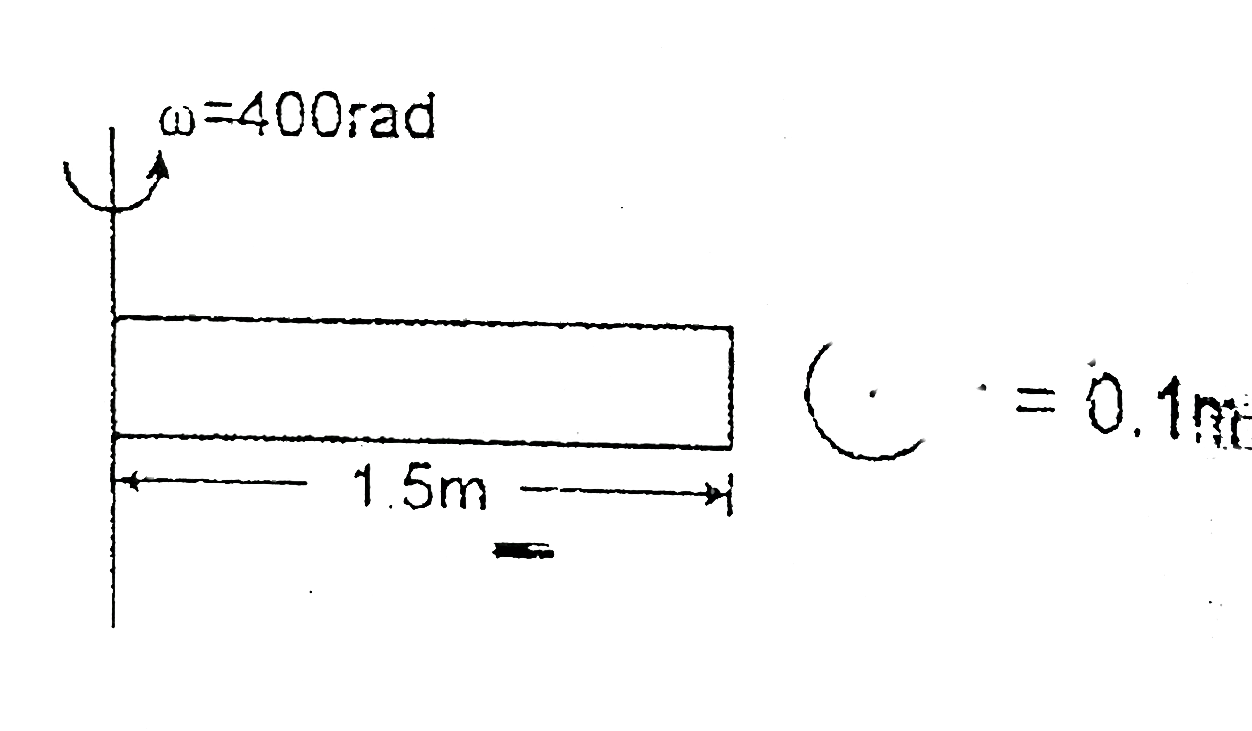An iron rod is subjected to cycles of magnetisation at the rate of 50Hz. Given the density of the rod is 8×103kg/m3 and specific heat is 0.11×10−3cal×kg∘C. The rise in temperature per minute, if the area enclosed by the B−H loop corresponds to energy of 10−2J is (Assume there is no radiation losses)
78∘C
88∘C
8.1∘C
none of these
The correct Answer is:C
To solve the problem step by step, we will follow these calculations:
Step 1: Determine the Energy Loss per Minute
The energy loss per cycle is given as 10−2J. The frequency of magnetization is 50Hz, which means there are 50 cycles per second. Therefore, the energy loss per second is:
Energy loss per second=Energy loss per cycle×Frequency=10−2J×50Hz=5×10−1J/s
To find the energy loss per minute, we multiply by 60 seconds:
Energy loss per minute=5×10−1J/s×60s=30J
Step 2: Relate Energy Loss to Temperature Rise
The energy loss can be related to the temperature rise using the formula:
Energy=mass×specific heat×ΔT
Where:
- ΔT is the rise in temperature,
- The mass m can be calculated as m=Volume×Density.
Step 3: Calculate the Mass of the Iron Rod
Let V be the volume of the iron rod. The density of the rod is given as 8×103kg/m3. Thus, the mass is:
m=V×Density=V×8×103kg/m3
Step 4: Substitute Mass into the Energy Equation
Substituting the mass into the energy equation gives:
30J=(V×8×103)×(0.11×10−3×4.2)×ΔT
Step 5: Calculate Specific Heat in Joules
Convert specific heat from calories to joules:
0.11×10−3cal/kg°C=0.11×10−3×4.2J/kg°C=0.462×10−3J/kg°C
Step 6: Rearranging the Equation for ΔT
Now we can rearrange the equation to solve for ΔT:
ΔT=30J(V×8×103)×(0.462×10−3)
Step 7: Substitute Volume to Find ΔT
Assuming V=1m3 for simplicity (as the volume will cancel out later):
ΔT=30(1×8×103)×(0.462×10−3)
Calculating this gives:
ΔT=308×0.462≈303.696≈8.11°C
Final Answer
The rise in temperature per minute is approximately 8.11°C.
---
The energy loss per cycle is given as 10−2J. The frequency of magnetization is 50Hz, which means there are 50 cycles per second. Therefore, the energy loss per second is:
Energy loss per second=Energy loss per cycle×Frequency=10−2J×50Hz=5×10−1J/s
To find the energy loss per minute, we multiply by 60 seconds:
Energy loss per minute=5×10−1J/s×60s=30J
The energy loss can be related to the temperature rise using the formula:
Energy=mass×specific heat×ΔT
Where:
- ΔT is the rise in temperature,
- The mass m can be calculated as m=Volume×Density.
Let V be the volume of the iron rod. The density of the rod is given as 8×103kg/m3. Thus, the mass is:
m=V×Density=V×8×103kg/m3
Substituting the mass into the energy equation gives:
30J=(V×8×103)×(0.11×10−3×4.2)×ΔT
Convert specific heat from calories to joules:
0.11×10−3cal/kg°C=0.11×10−3×4.2J/kg°C=0.462×10−3J/kg°C
Now we can rearrange the equation to solve for ΔT:
ΔT=30J(V×8×103)×(0.462×10−3)
Assuming V=1m3 for simplicity (as the volume will cancel out later):
ΔT=30(1×8×103)×(0.462×10−3)
Calculating this gives:
ΔT=308×0.462≈303.696≈8.11°C
The rise in temperature per minute is approximately 8.11°C.
Topper's Solved these Questions
- BOOK - NARAYNACHAPTER - MAGNETISMEXERCISE - NCERT Based Questions17videos
MAGNETISM
- BOOK - NARAYNACHAPTER - MAGNETISMEXERCISE - LEVEL-I (H.W)30videos
MAGNETISM
- BOOK - NARAYNACHAPTER - MAGNETISMEXERCISE - LEVEL-II(C.W)42videos
MAGNETISM
- BOOK - NARAYNACHAPTER - EXPERIMENTAL PHYSICSEXERCISE - Comprehension type6videos
EXPERIMENTAL PHYSICS
- BOOK - NARAYNACHAPTER - MAGNETISM AND MATTEREXERCISE - EXERCISE - 4 (SINGLE ANSWER TYPE QUESTION)17videos
MAGNETISM AND MATTER
Similar Questions
Knowledge Check
- Question 1 - Select One
If the young's modulus of the material of the rod is 2×1011N/m2 and its density is 8000kg/m3 then the time taken by a sound wave to traverse 1m of the rod will be
A10−4sB2×10−4sC10−2sD2×10−2s - Question 2 - Select One
An iron rod and another of brass, both at 27∘C differ in length by 10−3m. The coefficient of linear expansion for iron is 1.1×10−5/∘C and for brass is 1.9×10−5/∘C. The temperature at which both these rods will have the same length is
A0∘CB152∘CC175∘CDData is insufficient - Question 3 - Select One
Two metal spheres are falling through a liquid of density 2×103kg/m3 with the same uniform speed. The material density of sphere 1 and sphere 2 are 8×103kg/m3 and 11×103kg/m3 respectively. The ratio of their radii is :-
A118B√118C32D√32
Given Y=2×1011N/m2,ρ=104kg/m3
Find out elongation in rod.
 View Solution
View SolutionThe magnetic moment of a magnet of mass 75gm is 9×10−7A−m2. If the density of the material of magnet is 7.5×103kgm−3, then find intensity of magnetisation is
View SolutionWhat is the density of ocean water at a depth, where the pressure is 80.0 atm, given that its density at the surface is 1.03×103kgm−3? Compressibilty of water =45.8×10−11Pa−1. Given 1 atm. =1.013×105Pa.
View SolutionStrain energy of a wire is 1.8×10−3J and strain energy per unit volume of the same wire under the same conditions is 6×10−3J/m3. The volume of the wire will be
View SolutionA sphere of radius 50 cm is maintained at a constant temperature, radiates energy at the rate of 0.5 kcal/s. then the emissive power of sphere is (J=4.2×103J/kcal)
View Solution

